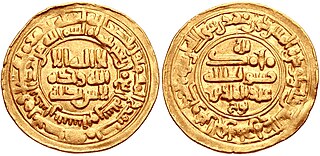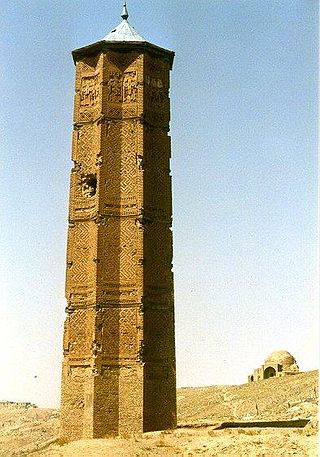
The Samanid Empire, also known as the Samanian Empire, Samanid dynasty, Samanid amirate, or simply as the Samanids, was a Persianate Sunni Muslim empire, of Iranian dehqan origin. The empire was centred in Khorasan and Transoxiana; at its greatest extent encompassing Persia and Central Asia, from 819 to 999.

Abd al-Malik I was amir of the Samanid Empire from 954 to 961. He was the son and successor of Nuh I. His reign was marked by internal strife, with the Turkic slave-soldiers increasing in power. He died after falling from his horse during a game of polo at Bukhara. He was succeeded by his brother Mansur I, who was put on the throne by a faction of ghulams led by the Turkic slave-commander, Fa'iq Khassa.

Nuh ibn Nasr, or Nuh I, was the Amir of the Samanids in 943–954. He was the son of Nasr II. It is rumoured that he married a Chinese princess.

Abu Salih Mansur, better known as Mansur I (منصور) was amir of the Samanids from 961 to 976. The son of Nuh I, his reign was characterized by weak rule and perpetual financial troubles. Mansur was notably the first Samanid ruler to the use title of King of Kings (Shahanshah), most likely as a response to his rival, the Buyid ruler Adud al-Dawla, who likewise used the title. He is also known by the sobriquet Amīr-i Sadid.

Nasr ibn Ahmad or Nasr II, nicknamed "the Fortunate", was the ruler (amir) of Transoxiana and Khurasan as the head of the Samanid dynasty from 914 to 943. His reign marked the high point of the Samanid dynasty's fortunes. He was the son of Ahmad ibn Isma’il.

Alp-Tegin, or Alptekin, was a Turkic slave commander of the Samanid Empire, who would later become the semi-independent governor of Ghazna from 962 until his death in 963.

Chaghaniyan, known as al-Saghaniyan in Arabic sources, was a medieval region and principality located on the right bank of the Oxus River, to the south of Samarkand.

Abu Ali Ahmad Chaghani was the Muhtajid ruler of Chaghaniyan (939–955) and governor of Samanid Khurasan. He was the son of Abu Bakr Muhammad.

The Simjurids were a Turkic family that served the Samanid emirs of Bukhara in the 10th century. They played an influential role in the history of eastern Iran and southern Afghanistan during that time, and by the second half of the 10th century they had built a semi-independent principality in Khurasan.
Abu 'l-Fadl Muhammad ibn Abi Abdallah al-Husayn ibn Muhammad al-Katib, commonly known after his father as Ibn al-'Amid was a Persian statesman who served as the vizier of the Buyid ruler Rukn al-Dawla for thirty years, from 940 until his death in 970. His son, Abu'l-Fath Ali ibn Muhammad, also called Ibn al-'Amid, succeeded him in his office.
Simjur al-Dawati was a 10th-century Turkic general who served the Samanids. He was the founder of the Simjurid family which would play an important role in the Samanid Empire.
Abu'l-Fadl al-Bal'ami, also known as Bal'ami the Elder, was a Samanid statesman from the al-Bal'ami family, who served as the vizier of Nasr II from 922 to 938.
Ibrahim ibn Ahmad, was the amir of the Samanids briefly in 947. He was the son of Ahmad Samani.
Abu Mansur Muhammad ibn 'Abd al-Razzaq ibn 'Abdallah ibn Farrukh, also simply known as Abu Mansur Muhammad and Ibn 'Abd al-Razzaq, was an Iranian aristocrat who served the Samanids during the most of career, and briefly served as governor of Azerbaijan under the Buyids.
Abu'l-Husain Abd-Allah ibn Ahmad Utbi, better known as Abu'l-Husain Utbi, was an Iranian statesman from the Utbi family, who served as the vizier of the Samanid ruler Nuh II from 977 to 982.
Mansur ibn Qara-Tegin, commonly known after his father as Ibn Qaratakin was a Turkic military officer of the Samanids in the mid-10th century.

Ali ibn Hasan, also known as Harun Bughra Khan and better known as Ali-Tegin was a Karakhanid ruler in Transoxiana from 1020 to 1034 with a brief interruption in 1024/25.
Abu Ishaq Ibrahim, also known as Ishaq ibn Alp-Tegin, was a Turkic officer, who was the Samanid governor of Ghazna from September 963 to November 966. He was the son and successor of Alp-Tegin.
Abu Bakr Lawik was a ruler of Ghazna from the Lawik dynasty. He was most likely a vassal of the Samanid Empire. In 962, the Turkic slave commander Alp-Tegin captured Ghazna after besieging the Citadel of Ghazni for four months. However, a few years later, Lawik managed to re-capture the town from Abu Ishaq Ibrahim, the son and successor of Alp-Tegin. This was not to last long; Abu Ishaq Ibrahim shortly returned to the town with Samanid aid, and took control of the town once again. Abu Bakr Lawik is thereafter no longer mentioned; he died before 977, the year that Ghaznavid control was established in Ghazna.

Ghazni is a city in southeastern Afghanistan, which served as the capital of the Ghaznavid Empire from 977 to 1163.